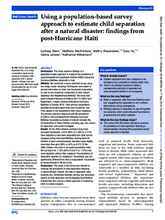Abstract
Introduction This study explores findings of a population-based approach to measure the prevalence of unaccompanied and separated children (UASC) during the Hurricane Matthew aftermath in Haiti.
Methods We conducted a cross-sectional survey using two-stage cluster sampling. Participants were asked to provide information on their own household composition, as well as the household composition of their closest neighbour (the Neighborhood Method). The study took place between February and March 2017 in Haiti’s Sud Department, a region severely affected by Hurricane Matthew in October 2016. 1044 primary respondents provided information about their own household, and 4165 people in the household of their closet neighbour. The primary outcome measured was the prevalence of UASC in the Sud Department following Hurricane Matthew. Secondary outcomes of interest included the characteristics of these children, including age, sex, reason for separation and current caregiver.
Results Of the 2046 children currently living in the surveyed households, 3.03% (95% CI 2.29% to 3.77%) were reported to have been separated from their normal caregiver during Hurricane Matthew. Among these 62 children, 9 were unaccompanied, and there were slightly more boys than girls (56% vs 44%, p=0.37). Of the 2060 children who lived in surveyed households when the hurricane hit, 1.12% (95% CI 0.67% to 1.57%) had since departed without their caregiver. The prevalence of separation reported for neighbours’ households was not significantly different from that in respondents’ households (p values between 0.08 and 0.29).
Conclusions This study is the first known attempt to measure the prevalence of child separation following a natural disaster. Overall, the rates of separation were relatively low. Similarities between primary and secondary reports of child separation via the Neighborhood Method indicate that this may be a viable approach to measuring UASC in certain contexts.

